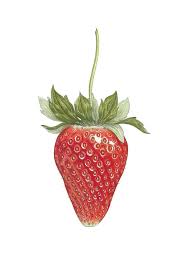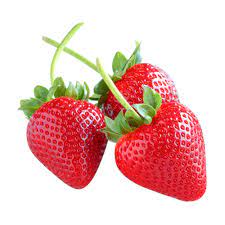Strawberry stems, also known as calyxes or sepals, are the leaf-like structures at the top of a strawberry fruit where the stem and the fruit meet. They are often green in color and are arranged in a circular pattern around the top of the fruit.
The calyxes provide protection to the developing strawberry as it grows. They act as a natural barrier against physical damage, pests, and diseases. Strawberry stems connect the fruit to the plant’s vascular system, allowing nutrients, water, and other essential substances to be transported to the fruit as it grows and develops.
The calyxes play a role in regulating the amount of water that enters and exits the fruit. They help prevent excessive water loss and dehydration from the fruit’s surface. Like other plant tissues, strawberry stems also enable respiration. They facilitate the exchange of gases, such as oxygen and carbon dioxide, which is vital for the metabolic processes occurring within the fruit.
Strawberry stems contribute to the overall appearance of the fruit. They can add a touch of green and natural beauty to the vibrant red color of the strawberries.
The Economic Importance and Uses of Strawberry Stems

Strawberry stems (also known as strawberry calyxes) are not commonly recognized for significant economic importance or a wide range of uses. However, strawberries as a whole have economic importance in the agricultural and food industries due to their popularity as a fruit. Strawberry stems themselves, though often discarded when consuming the fruit, could potentially have some niche applications.
Here are some of it uses and economic importance:
1. Culinary and Edible Uses: While the stems of strawberries are not typically consumed directly, they can be used in certain culinary applications. For example, they might be infused in water to add a subtle strawberry flavor to beverages or used in making jams and jellies to enhance the fruit’s flavor profile.
2. Potential Flavoring and Aroma Uses: Strawberry stems might be used in the production of natural flavorings or extracts, potentially contributing to a more authentic and rounded strawberry flavor in various food products, including baked goods, desserts, and beverages.
3. Herbal and Medicinal Uses: In traditional and herbal medicine, some parts of the strawberry plant, including the leaves and stems, have been used for their potential diuretic, anti-inflammatory, and anti-oxidant properties. However, scientific evidence supporting these claims is limited.
4. Natural Dye: Strawberry stems could potentially be used as a source of natural dye, although this is relatively uncommon. They might impart a pale color to textiles or other materials.
5. Composting and Agricultural Use: Strawberry stems, like other plant waste, can be composted to create nutrient-rich soil for gardening and agriculture. This can help improve soil structure and fertility.
6. Animal Feed: In some cases, agricultural waste including strawberry stems might be used as supplementary feed for certain livestock or as bedding material.
Read Also: Strawberry Petioles: Economic Importance, Uses and By-Products
7. Cosmetic and Skincare Industry: Strawberry stems might be explored for their potential use in cosmetic and skincare products. They could contain compounds that have antioxidant or moisturizing properties, although extensive research would be needed to validate their effectiveness.
8. Nutritional Supplements: Some plant materials, including strawberry stems, might be used in the formulation of nutritional supplements or herbal products. These products could claim potential health benefits associated with the nutrients present in the stems.
9. Bioactive Compounds Extraction: Strawberry stems might contain bioactive compounds such as polyphenols, flavonoids, and vitamins. These compounds could be extracted and used in the production of functional foods, dietary supplements, or even pharmaceuticals.
10. Research and Development: Scientific research could uncover novel compounds or properties within strawberry stems that might have applications beyond what is currently known. This research could contribute to various industries, from food to pharmaceuticals.
11. Environmental Applications: Extracts from strawberry stems might have potential use in environmental applications, such as in the development of eco-friendly pesticides or natural repellents for pests in agriculture.
12. Arts and Crafts: In artisanal and creative contexts, dried strawberry stems could potentially be used in crafts such as handmade papermaking, decorative arrangements, or even as part of natural sculptures.
The Products and By-products That Can Be Derived From Strawberry Stems

Strawberry stems, although often discarded, can be utilized to produce a variety of products and by-products.
Here are some examples:
1. Strawberry Stem Tea: Strawberry stems can be dried and used to make herbal tea. The stems contain antioxidants, vitamins, and minerals that can be extracted into the tea, providing a pleasant flavor and potential health benefits.
2. Natural Dyes: The stems can be used as a source of natural dye for textiles and crafts. They can yield various shades of green and brown when used for dyeing fabrics, paper, or other materials.
3. Compost: Strawberry stems are rich in organic matter and nutrients. They can be added to compost piles or bins to enhance the nutrient content of the resulting compost, which can then be used to enrich soil in gardens.
4. Animal Feed: After proper processing, strawberry stems can be incorporated into animal feed. This is particularly relevant for small-scale livestock or poultry farming, where the stems can contribute to the animals’ diet as a source of fiber and nutrients.
Read Also: Soybean Pods: Economic Importance, Uses and By-Products
5. Biofuel Production: In some cases, agricultural waste, including strawberry stems, can be converted into biofuels through processes such as anaerobic digestion or fermentation. This can contribute to renewable energy production.
6. Natural Fibers: The fibers from strawberry stems can be extracted and used for making paper, fabric, or other fiber-based products. While not as commonly used as other natural fibers, they can still find applications in niche markets.
7. Plant Mulch: Chopped or shredded strawberry stems can be used as mulch in gardening. They can help retain soil moisture, suppress weed growth, and gradually break down to enrich the soil.
8. Cosmetic and Personal Care Products: Extracts from strawberry stems can be used in cosmetic and personal care products such as skin creams, lotions, and shampoos. These extracts may contain antioxidants and other compounds that are beneficial for skin and hair health.
9. Biodegradable Packaging: With the increasing demand for sustainable packaging, biodegradable materials are becoming more important. Strawberry stems, if properly processed, could potentially be used to create biodegradable packaging materials.
10. Art and Crafts: Strawberry stems can serve as creative materials for art and crafts projects. They can be used for making natural wreaths, decorative items, or even sculptures.
In conclusion, it is important to note that the extraction and utilization of these products and by-products from strawberry stems might require specific processing methods and expertise. Additionally, not all stems are suitable for consumption or application due to potential pesticide residue or other contaminants. Always ensure proper cleaning, processing, and safety measures when working with agricultural waste for various purposes.
Read Also: What You Should Know Before Buying a Farm
